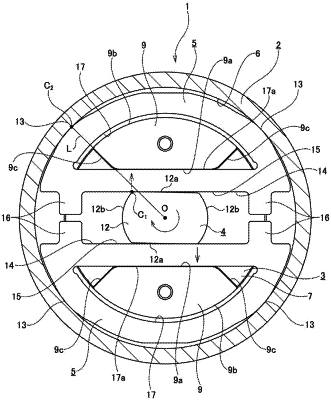| CPC F16D 43/18 (2013.01) [F16D 41/08 (2013.01)] | 4 Claims |

|
1. A reverse input cut-off clutch comprising:
a pressed member that includes a pressed surface provided on an inner peripheral surface;
an input member having at least one input-side engaging part disposed radially inside the pressed surface and disposed coaxially with the pressed surface;
an output member having an output-side engaging part disposed further inward in a radial direction than the input-side engaging part radially inside each of the pressed surface and disposed coaxially with the pressed surface; and
an engaging element having a pair of pressing surfaces facing the pressed surface and away from each other in a circumferential direction, an input-side engaged part which is engageable with the input-side engaging part, and an output-side engaged part which is engageable with the output-side engaging part, and disposed to be movable in a first direction that is a far-near direction with respect to the pressed surface,
wherein, the engagement element is configured to be displaced in a direction moving away from the pressed surface in the first direction based on that the input-side engaging part engages with the input-side engaged part when a rotational torque is input to the input member and is configured to transmit the rotational torque input to the input member to the output member based on that the output-side engaged part engages with the output-side engaging part,
the engagement element is configured to press the pressing surface against the pressed surface so that the pressing surface frictionally engages with the pressed surface based on that the output-side engaging part engages with the output-side engaged part when a rotational torque is reversely input to the output member,
a state in which, as the output member rotates in a predetermined direction, the pair of pressing surfaces are pressed against the pressed surface, and as the input member rotates in a direction opposite to the predetermined direction, the input-side engaging part is engaged with the input-side engaged part is set to be a first state, and
a state in which a rotational torque is reversely input to the output member and the pair of pressing surfaces are in contact with the pressed surface is set to be a second state,
when a direction perpendicular to both the first direction and a central axis of the input member is set to be a second direction,
wherein in the first state, a distance in the second direction between a contact portion between the input-side engaging part and the input-side engaged part and a rotation center of the input member is larger than a distance in the second direction between a contact portion between the output-side engaging part and the output-side engaged part and a rotation center of the output member, and
in the second state, the contact portion between the output-side engaging part and the output-side engaged part is located closer to the rotation center of the output member in the first direction than an imaginary straight line connecting a contact portion between one pressing surface of the pair of pressing surfaces and the pressed surface to the rotation center of the output member.
|